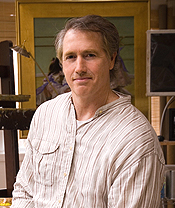BIOGRAPHY - Mark Eliot Lovett (Born 1956)

“Fear of following our calling holds us back. If we can follow what we feel called to do, it will push the fear out.” Mark Lovett’s comment reflects his experience, as well as the essence of his journey as a painter.
Born and raised in a family of attorneys in Maryland, Lovett turned instead to a musical career beginning with his first professional guitar and singing engagement at age fourteen. During the 1970s and 1980s, he worked primarily as a musician, playing in bars and clubs on the east coast. Along the way, he also received a business degree from the University of Maryland. Lovett worked as a professional musician until the late 1980s, when he and his wife began their family, at which point he felt the need for a more reliable income, and decided to put his business background to a more traditional use. Although he continues to work occasionally as a professional musician today, he now considers it an avocation rather than a career.
Throughout the 1990s, Lovett was a successful self-employed businessman, but not an especially contented individual, and in October 1998, he made the decision to seek treatment for alcohol and drug dependency. Two and a half years into his recovery, his wife asked him to pick up art supplies for their young daughter’s birthday party. Having purchased paints, papers and crafting supplies, Lovett subsequently joined in the birthday party festivities, and more importantly, realized that he thoroughly enjoyed painting. Soon, he was attending workshops and classes in the visual arts, studying books, visiting museums, and painting daily.Not long afterward, he discovered that art was very therapeutic for his recovery. After painting forty to eighty hours a week for about five years, with his career re-focused on what he describes as “meaningful work”, Mark was well on his way to establishing himself as a professional painter.
Lovett’s initial studies took him to the Art League School in Alexandra, Virginia where he worked with the realist painter Robert Liberace and began to explore the abundant museum offerings in the region. Later he studied at Nelson Shanks’ Studio Incamminati in Philadelphia, where he learned the fundamentals of figurative and portrait painting in the traditional academic style. Next, he traveled to Florence, Italy to learn from the old masters first hand in the Uffizi Gallery and elsewhere.
In keeping with his study of figurative painting, Lovett began creating images of children. His early work included some memorial portraits of children whose families had provided him with photographs of the deceased son or daughter. For Lovett, the interaction with these families was essential; as he notes, “I put my heart and soul in it”. The realization that painting has the power to conveyfeeling to other people was essential to creating the meaningful work that Lovett had felt was lacking in his business career.
As his technical skills evolved, Lovett developed his own method of blending traditional compositional tools withtwenty-first century technology. Typically, his process begins with notes, sketches and a vast number of photographs. Like his nineteenth-century predecessors, he then works out his composition by editing elements until he has the right solution for the image. He remarks that “composition is often challenging--sometimes a struggle and sometimes effortless.” One of those challenges is that the saturation of each color can occasionally create a lack of balance in the composition. However, Lovett has discovered that some basic photography software can be helpful in assessing values of light and shadow simply by “de-saturating” the color. What emerges as a result is a clear depiction of the value contrasts--unhampered by the intensity of any particular hue. With this information in hand, the artist can then adjust the colors on the canvas to obtain the desired effects.
In contrast to his use of contemporary technological tools, Lovett remains grounded in the tradition of figure painting and portraiture, looking especially to the latenineteenth century portrait painters such as John Singer Sargent (1856-1925) and Anders Zorn (1860-1920). Sargent’s remarkably painterly handling of fabrics--satins, silks, furs and lace--has been a key influence on Lovett’s painting, as has his impressionistic use of light and texture. As a portrait painter, Sargent also excelled at capturing the spirit of his sitters so that viewers could perceive what was unique and essential about the individual.
Lovett strives for that same level of insight. In his images of children, he expressly aims for a candid and active composition, capturing the moment when his young models are engaged in doing something that intrigues them. His series of paintings of ballerinas is a case in point. Although the influence of Edgar Degas’s famous ballerina paintings is undeniable, the differences are as noteworthy as the similarities. Most obviously, Lovett’s ballerinas are very young girls, and they are having fun in their modest ballet studio, no doubt preparing for a recital for their families and friends. Like Degas (1834-1917), Lovett focuses on representing a specific, fleeting glimpse of contemporary life, but the artlessness of these children is in direct contrast to the worldly awareness of Degas’s ballet “rats” at the Paris Opera House.
Most important for Lovett is his sense of painting what he is passionate about, creating images that speak clearly to his audience and that engender a meaningful response in his viewers.
Janet Whitmore, Ph.D.
